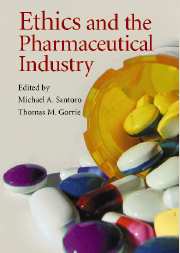Book contents
- Frontmatter
- Contents
- Tables
- Figures
- About the Editors
- Contributors
- Preface
- Acknowledgments
- Foreword
- Introduction: Charting a Sustainable Path for the Twenty-First Century Pharmaceutical Industry
- PART I PROFITS, PATIENTS' RIGHTS, AND SCIENTIFIC PROGRESS: THE ETHICS OF CLINICAL RESEARCH CONDUCTED IN PRIVATE ENTERPRISES
- PART II MARKETING AND THE EFFICIENT UTILIZATION OF HEALTHCARE RESOURCES: ETHICAL AND PUBLIC POLICY CHALLENGES
- Introduction to Part II
- 8 Ethics and Prescribing: The Clinician's Perspective
- 9 The Regulation of Prescription Drug Promotion
- 10 Direct-to-Consumer Advertising of Prescription Drugs: A Policy Dilemma
- 11 Off-Label Communications and Prescription Drugs
- 12 The Need for Better Health Information: Advancing the Informed Patient in Europe
- 13 Who Should Get Access to Which Drugs? An Ethical Template for Pharmacy Benefits
- 14 The Application of Cost-Effectiveness and Cost–Benefit Analysis to Pharmaceuticals
- PART III PATENTS, PRICING, AND EQUAL ACCESS
- PART IV CONCLUDING THOUGHTS: CHARTING A SUSTAINABLE PATH FOR THE TWENTY-FIRST CENTURY
- Notes
- Index
11 - Off-Label Communications and Prescription Drugs
Published online by Cambridge University Press: 04 December 2009
- Frontmatter
- Contents
- Tables
- Figures
- About the Editors
- Contributors
- Preface
- Acknowledgments
- Foreword
- Introduction: Charting a Sustainable Path for the Twenty-First Century Pharmaceutical Industry
- PART I PROFITS, PATIENTS' RIGHTS, AND SCIENTIFIC PROGRESS: THE ETHICS OF CLINICAL RESEARCH CONDUCTED IN PRIVATE ENTERPRISES
- PART II MARKETING AND THE EFFICIENT UTILIZATION OF HEALTHCARE RESOURCES: ETHICAL AND PUBLIC POLICY CHALLENGES
- Introduction to Part II
- 8 Ethics and Prescribing: The Clinician's Perspective
- 9 The Regulation of Prescription Drug Promotion
- 10 Direct-to-Consumer Advertising of Prescription Drugs: A Policy Dilemma
- 11 Off-Label Communications and Prescription Drugs
- 12 The Need for Better Health Information: Advancing the Informed Patient in Europe
- 13 Who Should Get Access to Which Drugs? An Ethical Template for Pharmacy Benefits
- 14 The Application of Cost-Effectiveness and Cost–Benefit Analysis to Pharmaceuticals
- PART III PATENTS, PRICING, AND EQUAL ACCESS
- PART IV CONCLUDING THOUGHTS: CHARTING A SUSTAINABLE PATH FOR THE TWENTY-FIRST CENTURY
- Notes
- Index
Summary
The Federal Food, Drug, and Cosmetic Act (FDCA) prohibits pharmaceutical manufacturers from promoting their products for uses that have not been approved by the federal Food and Drug Administration (FDA). Manufacturers must prove, by a rigorous evidentiary standard, that drugs are safe and effective for each use for which a drug is promoted. If a manufacturer promotes a product for a use that is not approved by FDA, and thus inconsistent with a product's approved label, the promotion is referred to as “off-label” promotion.
Policing off-label promotion is one of the key facets of the FDA's regulation of prescription drug marketing. The agency requires, moreover, that all promotional messages contain “fair balance,” including safety information and relevant warnings about the drug product. In this way, the FDA encourages the dissemination of accurate and complete information about approved uses for prescription drugs.
But over the past several years, two developments have emerged with respect to off-label communications about prescription drugs. First, there has been a burgeoning recognition that the FDA's authority to regulate communications about prescription drugs is not just limited by the authority granted by Congress in the FDCA, but restricted by the free speech principles of the First Amendment. A series of judicial decisions have held that the free speech protections afforded by the First Amendment apply to communications about products regulated by the FDA. These decisions have signaled that manufacturers may have greater opportunities to communicate limited off-label information than the traditional FDA policies allow.
- Type
- Chapter
- Information
- Ethics and the Pharmaceutical Industry , pp. 184 - 195Publisher: Cambridge University PressPrint publication year: 2005
- 1
- Cited by



